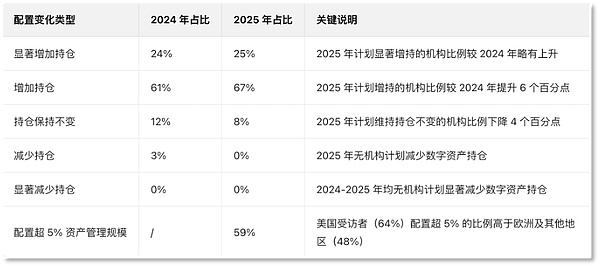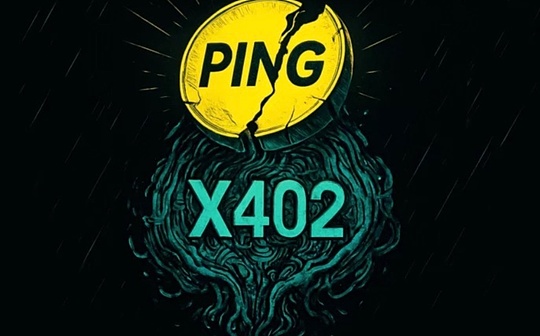
Author: Luoluo
Recently, the world-renowned investment bank JPMorgan Chase“Plans to accept global institutional clients’ Bitcoin and Ethereum holdings as loan collateral“, this news was once again regarded by the encryption industry as“Institutional recognition“important indicator.
In fact, behind the rise of Bitcoin leading the crypto asset market in the first half of the year, institutional investors are the key“push hands“.WithETH,SOL,BNBAfter being included in the asset reserves of some listed companies and even being used as a treasury target by many companies, the institutional market once again showed strong incremental potential.
According to Ernst & Young-CoinbaseJointly released “2025The Annual Institutional Investor Digital Asset Survey Report shows that institutional investors who are influential in asset allocation decisions, such as asset management companies, hedge funds, private banks, venture capital funds, and family offices, have all developed a strong interest in crypto assets.The report states86%of institutional investors surveyed already have exposure to digital assets and plan to2025The configuration will be further expanded after the year.
The entry of institutional investors is closely related to the progress of compliance supervision of crypto assets in multiple jurisdictions. At the same time,Coinbase,BinanceThe world’s top crypto-asset exchanges are also increasing and optimizing investment tools for institutional customers in order to gain a firm foothold.“Institutional bull“outlet.
Institutional demand for crypto asset investments surges
“Institutional demand drives record growth.“2025year10In March, Chicago Mercantile Exchange Group (CME Group) disclosed in its third-quarter cryptoasset market insights report that its cryptoasset futures and options trading volume exceeded9000billion, a record high.
In the second half of this year, the world’s leading crypto asset trading platformBinanceIt has stepped up its efforts to launch a number of services for institutional customers.
this year7month,BinanceLaunched institutional lending business to provide institutional customers with cross-collateralization functions between spot, cross-margin and unified accounts.Immediately afterwardsBinanceAnnounced to the public, designed for compliance agenciesBinanceThe third-party custody service will waive the handling fees for pledged assets before the end of the year.
since9month30day starts,BinanceEncryption as a Service for Institutions (CaaS) solution will open early access to mature licensed banks, brokers and trading platforms.
BinanceA series of actions have quickly responded to the current surge in institutional crypto asset allocation needs.
《2025The Annual Institutional Investor Digital Asset Survey Report shows that59%of institutional respondents plan to exceed5%of assets under management are allocated to crypto assets; institutions are also allocating more than just holding Bitcoin (BTC), Ethereum (ETH), Ripple (XRP),Solana(SOL) and other mainstream crypto assets, and will also delve into pledges, loans, derivatives, etc.DeFiscene, yes57%of respondents include tokenized assets“Plan configuration“within the scope to achieve diversification of the investment portfolio.

Month-on-month changes in institutional allocation of crypto assets
Currently, traditional asset management companies and hedge funds are the most mainstream institutional clients with the largest amount of funds.
According to public information, hedge funds such asBridgewater(Bridgewater),Renaissance Technologiesetc., have used crypto assets as part of their global macro strategy to hedge against the depreciation of legal currencies, or include investment in emerging asset classes;Millennium ManagementSuch a multi-strategy hedge fund might trade cryptoassets for early gains.
Investment banks and asset management institutions such as Goldman Sachs and JPMorgan Chase have begun to provide crypto asset derivatives, such as futures, options, and swaps, to institutional clients, and execute large transactions on exchanges on behalf of clients;BNY Mellon(Bank of New York Mellon),State Street(State Street Bank) has entered the digital asset custody service market.
asBinanceVIPand institutional business leadersCatherine ChenAs described,“The demand for digital assets is growing faster than ever before, and traditional financial institutions can no longer sit back and watch.However, building a crypto asset service system from scratch is complex, expensive, and risky.Therefore, we created‘Cryptoassets as a service’——A ready-to-use infrastructure solution that organizations can trust.“
As early as2018yearIn May, U.S. crypto asset trading platformCoinbasebegan to launch products for institutional investors, claiming that“There have been more than100Home Hedge Fund Announces Plans to Trade and Invest in Crypto Assets“, which shows that institutional clients’ interest in digital assets has increased from7Produced years ago.CoinbaseIt also followed the trend and launched an institutional-level hosting service platform at that time, and added products suitable for institutions in the following years.
There is no doubt thatCoinbase,BinanceTop crypto asset trading platforms such as Cryptocurrency Exchange have become an important bridge between traditional finance and the new finance of digital assets.
For a trading platform at the top of the crypto-asset industry chain, gaining widespread recognition from institutional customers not only means a huge custody scale and transaction volume, but more importantly, proves that emerging finance supported by blockchain can be widely adopted.
BinanceHow to build institutional trust?
If they want to win the favor of asset management companies, hedge funds, and banks, exchanges must meet the needs of institutions.
《20252020 Institutional Investor Digital Asset Survey Report shows that institutions are willing to allocate crypto/The top three reasons for digital assets are, in order“Higher returns than other asset classes“(59%),“Invest in innovative technology“(49%),“Hedging against inflation“(41%); while key concerns include regulatory uncertainty (52%), volatility (47%), asset custody security (33%).
It can be seen that compliance and security are still the factors that institutions are most concerned about when entering crypto assets, and they are also the first trust issues that crypto asset trading platforms solve when accepting institutional customers.
in anticipation32.8In the billion-dollar global custody market, not all platforms can provide true institutional-level security and clear regulatory support, so licensed and compliant institutional-level custody services are crucial.
Currently, such asAnchorage Digital, Bank of New York Mellon,Sygnum BankTop custodians such asOCC,NYDFS,FINMALicenses, as well as comprehensive audits issued by world-renowned accounting firms, which makes them become hedge funds, mainstream brokers, liquidity providers,FintechThe company’s preferred custodian.
BinanceWhen building an institutional customer service system, priority is given to solving compliance and security needs, as early as2023year12month,BinanceIt launched the cryptocurrency exchange industry’s first bank tripartite cooperation model, allowing investors to store trading collateral outside the exchange while continuing toBinanceSeamless transactions on the platform.Among them,Sygnum BankThat’s itBinanceOne of the three-party banking partners.The digital banking group holds a Swiss banking license and also has a presence in SingaporeCMSand major payment institution licenses, withBinanceCooperate to provide custody and trading services to institutional clients such as hedge funds and brokers.
Binanceat7Starting to support tokenized real assets (RWA), for exampleUSCYandcUSDO, allowing institutional clients to hold these income-generating tokenized assets through tripartite banking partners in addition to traditional collateral such as legal tender and government bonds.
this year8In March, according to the Financial Times, the Bank of SpainBBVAalso withBinanceA three-party banking agreement was reached to allow customers to store their digital assets in accounts outside of crypto-asset exchanges, adding asset security custody options.Under the new structure,BBVAClient funds are held in custody in the form of U.S. Treasury securities, whileBinanceThese treasury bonds are accepted as transaction collateral.
This structure follows the model long adopted by traditional financial markets and greatly reduces counterparty risk.By separating custody and execution, institutions can better coordinate crypto asset management with internal risk control and external compliance requirements without sharing assets or losing control.
While building trust safely,Binancealso forVIPWe have built a full range of products to meet the trading needs of institutions, including bulk trading services, derivatives, institutional lending, etc.
This year9month,BinanceLaunched again“Cryptoassets as a service“(Crypto-As-A-ServiceThat isCaaS) solution, trying to capture more traditional institutional customers from an experience level.

Binance launches CaaS solution
Binance CaaSThe solution is designed for large-scale regulated financial institutions that plan to enter the crypto-asset market on a large scale. It seamlessly integrates multiple functions such as trading, liquidity acquisition, custody, compliance and settlement into the institution’s own platform system, thereby eliminating the high cost and technical burden of developing complex infrastructure from scratch.
Compared to other service providers in the industry,Binance CaaSThe core innovation lies in: it willBinanceThe combination of global order book access and the institution’s internal liquidity enables the institution to“best price match“way to directly match orders between its own customers.
This efficient use of internal liquidity not only significantly improves transaction efficiency and reduces costs, but more importantly, due to theBinanceDeep integration of the underlying infrastructure allows direct access even if the order size within the organization is limitedBinanceGlobal spot and futures markets, enabling consistent execution experience and tight spread performance.
Public data shows that as of now,BinanceInstitutional client registrations increased year-on-year97%, the average daily trading volume has reached880billion dollars.BinanceSuch emphasis on institutional customers is not only due to market share considerations, but also to promote“financial inclusion“long-term strategic goals.
BinanceCEORichard TengSaid that in addition to the need for a sound regulatory and compliance system to promote the large-scale adoption of crypto assets, institutional adoption is becoming a key driving force.“Think about FX, commodities, stocks and bonds, there is always the institutional adoption layer first, then corporates, high net worth individuals and finally retail investors.“
He pointed out that since last year, the industry has undergone earth-shaking changes——The United States takes the lead in approving crypto assetsETF, followed by approvals around the world.“Ultimately, it gave crypto assets the credibility they deserved, and we saw a dramatic increase in adoption.Fidelity, BlackRock, Charles Schwab and even JPMorgan Chase have all gone from being crypto asset skeptics to now being believers and offering crypto products.So, the institutional wave is coming.”





